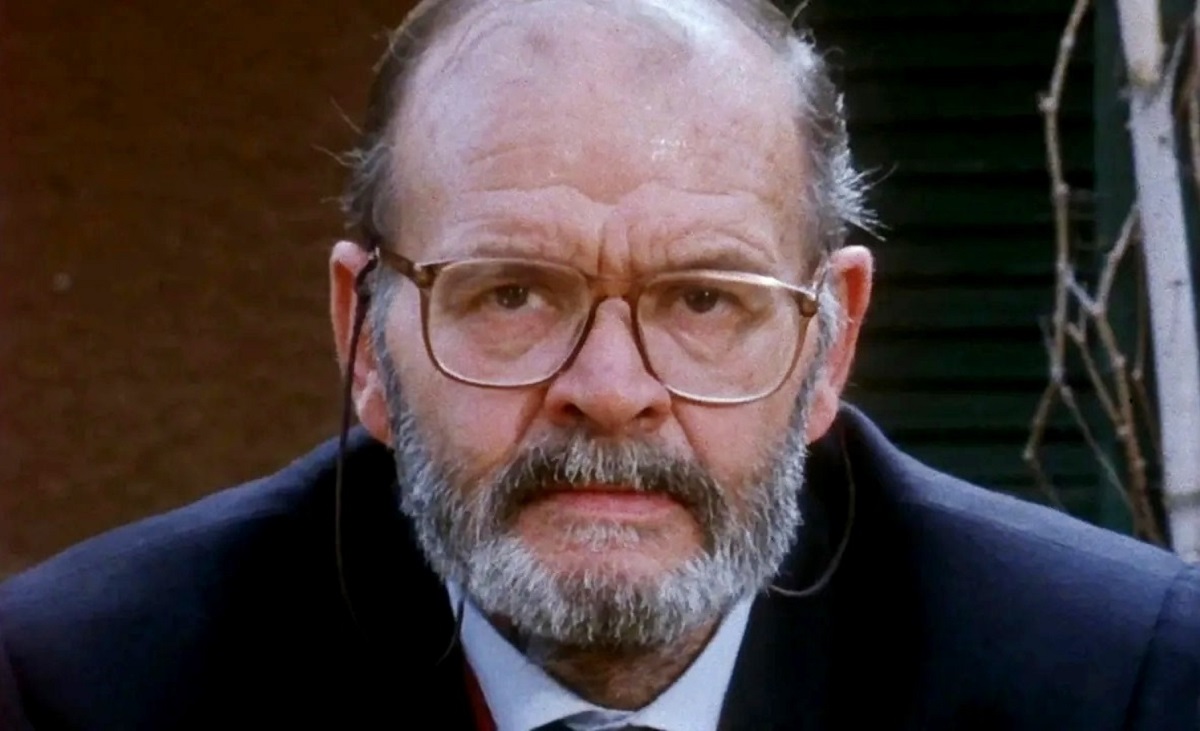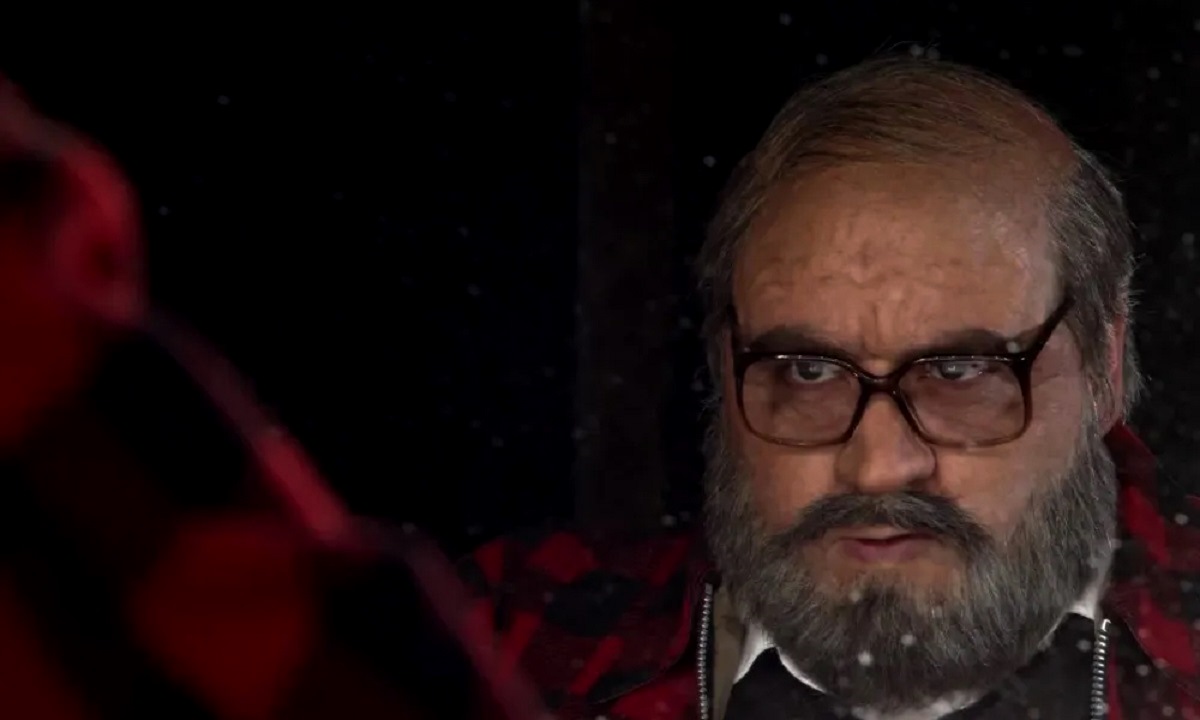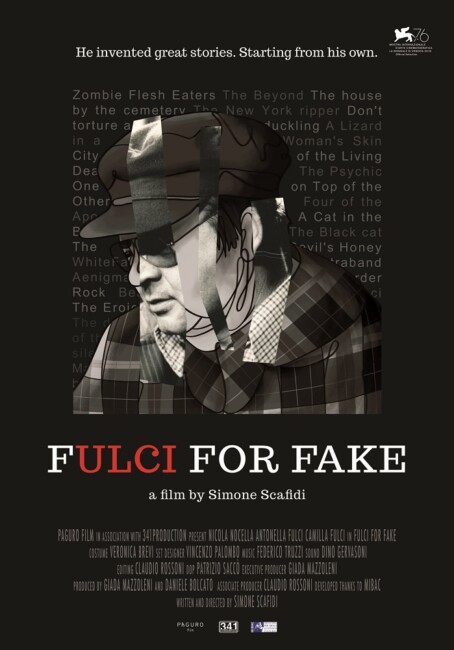Italy. 2019.
Crew
Director/Screenplay – Simone Scafidi, Producers – Daniele Bolcato, Giada Mazzoleni & Claudio Rossoni, Photography – Patrizio Sacco, Music – Federico Truzzi, Makeup Effects – Michele Salgaro Vaccaro, Production Design – Vincenzo Palombo. Production Company – Paguro Film LTD/341 Production.
Cast
Nicola Nocella. With: Sandro Bitetto, Fabio Frizzi, Antonella Fulci, Camilla Fulci, Paolo Malco, Davide Pulici, Michele Romagnoli, Sergio Salvati, Michele Soavi, Berenice Sparano, Enrico Vanzinas
Lucio Fulci (1927-96) was an Italian director who developed a cult following for his horror films. The particular films that sparked the Fulci cult were Zombie – Flesh Easters (1979), City of the Walking Dead (1980), The Beyond (1981), The House By the Cemetery (1981) and The New York Ripper (1981). The films themselves are often incoherent on a narrative level but what drives them is some full-on gore effects and a series of bizarre despatches. (A full list of Fulci’s other genre film is at the bottom of the page).
Fulci for Fake is a documentary about Fulci that covers his life and various of his films. It is not so much a chronicle of the making of these films as it is of Fulci’s life and the way in which aspects of this wove into his films. A variety of actors and crew who worked on the films are interviewed, as well as both of Fulci’s daughters. Italian critic Davide Pulici discusses Fulci’s films in terms of their themes. Oddly enough, we never actually get any clips from the films themselves (no doubt due to copyright issues).
The title Fulci for Fake seems an obvious reference to Orson Welles’ F is for Fake (1974), a documentary that Welles made about art forgers. That said, I am not entirely clear why the film was called such – it is not as though this is a film that ever exposes Fulci as being a fraud. There is brief discussion towards the end of a couple of occasions where he told exaggerated exploits but that seems to be stretching a point.
There is also the oddity of the casting of Nicola Nocella, a regular Italian actor in assorted dramas. The film opens with Nocella putting on a wig and facial appliance to make him up to look like Fulci, which is accompanied by a voiceover where Nocella tells us how he is going to be playing Fulci in a film. We never actually see anything of this film beyond a couple of brief clips with Nocella and various women. It should also be said that Nocella has a number of physical dissimilarities to the real Fulci – he is much bigger physically and more heavyset around the face; he’s like a Fulci who has really been hitting the pasta, whereas the real Fulci has a much more average build and smaller face.

The oddity of this is that after this framework where we are told Nocella is going to play Fulci, it then gets to be Nocella who goes out and interviews the various subjects (on the pretext that he is doing research for the role on the orders of his director). On the other hand, it is these interview scenes that make up the bulk of the documentary, while the scenes where Nocella plays Fulci form a very minor part.
Fulci for Fake covers most of Fulci’s life and career. As Davide Pulici notes, the first thirty or so films that Fulci made – mostly comedies – are not worth checking out, nor are the ones getting deluxe dvd restorations. Pulici makes some interesting comments on Fulci’s portrayal of sexuality – how the women in his films of the 1960s seem carefree and a few years later have become more ambiguous, while later works like The New York Ripper seems to be working out a violence against women. I would be curious to know what motivated the psychological changes on Fulci’s part but the film never much delves into his relationships. We get the sense that he was quite a player – daughter Camilla talks about him spending the night with a teenage actress on the set of Aenigma (1987), while Paolo Malco recounts an amusing anecdote about Fulci getting him to pretend to be a lawyer to get rid of a Caribbean woman after Fulci proposed to her.
The most emotive parts of the film come towards the end. We learn the story of how Fulci’s daughter Camilla suffered a horse-riding accident that left her paralysed, although she subsequently recovered and got up to walk. She gets the bulk of the interview time and appears in a wheelchair (although this was due to other medical problems subsequent to the accident). She also died in 2019, between Fulci for Fake’s shooting and its release, adding a tragic dimension to the show. Some analysis is spent on how Fulci changed the script of The New York Ripper to have the killer motivated by his daughter who had been hospitalised. Fulci’s other daughter Antonella only appears briefly towards the end.

The saddest aspect is Fulci himself and the story of his downward spiral in the 1990s where most regard his films as taking a severe decline in quality. This was all due to his undergoing heart surgery in 1985, which left him with health complications and struggling to work with some difficulty. The story is told of how he met Dario Argento at an awards ceremony and Argento was so moved by Fulci’s circumstances that he pushed for the two of them to collaborate on a film that would have been Fulci’s comeback. We see some of this film Wax Museum (1997), but Fulci died in March 1996 before production began and it was taken over by another director.
Does Fulci for Fake give an insight to Fulci the man? I enjoyed learning more about him but I felt the documentary never truly dove inside him and the forces that made him tick. It is part of the film’s frustration that it devotes time to analysing Fulci – his relationships and affairs, his grumpiness on set, his artistic sensibilities, how everyone talks of his friendliness – but you are left at the end with no clearer a picture of who he was as a person than you have at the outset.
Director Simone Scafidi subsequently went on to make another documentary about an Italian director with Dario Argento Panico (2023).
Lucio Fulci’s other films are:– Perversion Story (1969), Lizard in a Woman’s Skin (1971), Don’t Torture a Duckling (1972), Dracula in the Provinces (1975), The Psychic (1977), Zombie – Flesh Eaters (1979), City of the Living Dead/Gates of Hell (1980), The Beyond/The Seven Doors to Death (1981), The Black Cat (1981), The House By the Cemetery (1981), The New York Ripper (1981), Manhattan Baby/Eye of the Evil Dead/The Possessed (1982), Conquest (1983), Rome 2072 A.D. (1983), Murderock (1984), The Devil’s Honey (1986), Aenigma (1987), The Ghosts of Sodom (1988), Touch of Death/When Alice Broke the Mirror (1988), Zombi 3 (1988), Demonia (1990), A Cat in the Brain/Nightmare Concert (1990), Hansel and Gretel (1990), Voices from Beyond (1991) and Door to Silence (1992). Aenigma: Lucio Fulci and the 80s (2017) is another documentary about Fulci.
Trailer here


